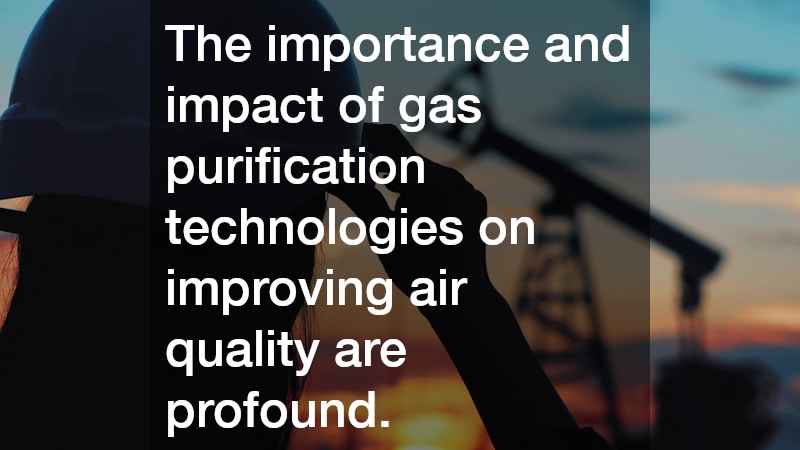This article delves into the top gas purification technologies that are significantly impacting air quality. With rising concerns about air pollution, understanding these technologies has never been more crucial.
1. What are the most effective technologies for gas purification?
Activated Carbon Filters
Activated carbon filters have gained prominence due to their exceptional ability to adsorb gases and pollutants. The porous nature of activated carbon provides a massive surface area for capturing contaminants, making it highly effective in both industrial and residential applications.
However, due to their saturation with pollutants, they require regular replacement and careful disposal.
Regular maintenance is essential to sustain their performance, emphasizing the importance of scheduled replacements. These filters are integral in reducing exposure to hazardous gases in enclosed spaces, thus improving overall air quality. As the demand for clean air increases, the innovation in enhancing their adsorption capacity becomes crucial.
Catalytic Converters
Catalytic converters are ubiquitous in the automotive industry, where they play a critical role in reducing vehicular emissions. They work by facilitating chemical reactions that convert harmful gases into less harmful substances, such as nitrogen, oxygen, and water vapor. The use of precious metals like platinum, palladium, and rhodium in these converters catalyzes the conversion process efficiently.
Innovations in catalytic converter design focus on enhancing efficiency while reducing the dependency on costly materials. The widespread implementation in automotive systems underscores their contribution to cleaner air but also highlights the challenges of high costs and metal scarcity. As regulatory standards tighten, ongoing advancements aim to further decrease vehicular pollution.
2. How do these technologies impact air quality?
Reduction in Pollutant Levels
Implementing gas purification technologies is pivotal in reducing pollutant levels in the atmosphere. Activated carbon filters, electrostatic precipitators, and catalytic converters each target specific pollutants, contributing to a significant cumulative decrease in air contaminants. Collectively, these technologies address a wide spectrum of emissions, ranging from particulate matter to chemical gases.
The combination of technologies ensures a comprehensive approach to combat airborne pollutants effectively. Industries and municipalities adopt tailored solutions that incorporate these technologies in different configurations to address specific air quality challenges. This adaptability is crucial for achieving local and global air quality standards, ultimately leading to healthier environments.
Improvement in Public Health
Quality air translation to a decrease in pollutant-related health conditions, directly influencing public health outcomes. Cleaner air significantly reduces the prevalence of ailments such as asthma, bronchitis, and cardiovascular diseases. Through technological intervention, individuals experience improved overall health, defined by fewer hospital admissions and lower medical costs.
Communities benefit from cleaner air, which results in a better quality of life and increased lifespan. The correlation between improved air quality and public health cannot be overstated, reinforcing the importance of adopting effective gas purification technologies. Maintaining these technologies ensures ongoing protection of public health and fosters environments conducive to wellness.
Environmental Benefits
Gas purification technologies significantly contribute to environmental conservation by reducing emissions that lead to climate change. Technologies like catalytic converters drastically cut the release of greenhouse gases from vehicles, slowing global warming. Activated carbon filters also remove volatile compounds that contribute to environmental degradation.
The adoption of these technologies illustrates a commitment to sustainable practices that benefit the planet as a whole. By supporting cleaner air through efficient purification methods, societies drive advancements in climate change mitigation and ecosystem protection efforts. These accomplishments highlight the holistic advantages of adopting comprehensive air purification strategies.
3. What are the future developments in gas purification technologies?
Advanced Material Use
Researchers are continually exploring advanced materials to enhance the efficiency of gas purification technologies. Nanomaterials, with their unique surface properties, are at the forefront of this innovation, enabling more effective pollutant capture. By incorporating these materials into existing technologies, scientists aim to overcome current limitations and achieve unprecedented purification performance.
Such innovation would benefit industries and consumers by providing more effective and sustainable air purification solutions. Enhanced gas purification processes align with stringent emission standards and regulatory requirements while supporting environmental sustainability goals. This continued evolution reflects the critical role of technological progress in meeting future air quality challenges.
Integration with Renewable Energy
The integration of top gas purification technologies with renewable energy systems represents an exciting frontier for sustainable development. By combining solar or wind energy systems with purification processes, industries can achieve cleaner air with reduced carbon footprints. This synergy enhances the sustainability and efficiency of industrial operations and residential applications.
The collaboration between gas purification and renewable energy technologies illustrates a comprehensive approach to sustainability. This integration enhances the viability and attractiveness of clean technology investments, bolstering progress towards a carbon-neutral future. As innovation continues, more sectors will adopt these combined solutions, boosting overall sustainability efforts.
Smart Monitoring Systems
The advent of smart monitoring systems is transforming how gas purification technologies are managed and optimized. By utilizing IoT and AI capabilities, these systems provide real-time data on air quality, enabling dynamic adjustments to purification processes. This advancement ensures technologies operate at peak efficiency, meeting variable air quality demands effectively.
Smart systems offer predictive maintenance alerts, reducing downtime and enhancing system reliability. By continuously monitoring performance metrics, these systems facilitate proactive management and resource allocation. This tech-driven approach leads to improved purification outcomes and helps businesses comply with environmental regulations efficiently.
The importance and impact of the top gas purification technologies on improving air quality are profound. These technologies play a crucial role in reducing air pollutants, enhancing public health, and conserving the environment. As advancements continue, future developments promise to expand and optimize these capabilities, ensuring a cleaner and healthier world for future generations.
